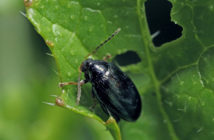OSR plots tested in Herefordshire, Wales and the south west have revealed that between 80-100% of petals have tested positive for Sclerotinia.
However, ADAS plant pathologist Caroline Young says that doesn’t mean the threat from Sclerotinia is necessarily restricted to these areas.
Drier conditions in the east means that there is less infection present but the risk could be as great. “High petal infection is only a pointer to the potential risk. Ascospores need temperatures of 7°C or above for 24 continuous hours with 80% humidity to germinate. Many crops in Herefordshire, Wales and the south west are particularly forward. By the time the weather turns warm, these could miss the majority of infection events. It all depends on how long flowering lasts for.
“Further east and north many crops are less developed and infection events could land as crops reach and move beyond mid flower. If flowering is extended these crops could be particularly vulnerable. Later infections are usually less damaging than early flower infections, but can still cause a significant yield loss,” she warns.
Bayer’s Jack Hill says it is crops hit by cabbage stem flea beetle that he is most concerned about. “Many crops are racing to mid-flower but those recovering from slow establishment, especially where there was flea beetle and pigeon damage are a little further behind. These could require a second spray if flowering is extended.”
With cooler weather forecast he hopes that infection events will be ‘few and far between’ and recommends growers treat crops with a 0.46 L/ha dose of Proline275 (prothioconazole) and monitor from there. “The importance of a well-timed mid-flower spray cannot be overstated, both to guard against Sclerotinia but also to prevent light leaf spot (LLS) moving up the canopy. Protecting the pods from LLS is vital, as it can cause early senescence and pod shatter.
“If flowering is extended then there is little choice but to come in with a second protective treatment as fungicides only offer two to three weeks protection, especially in high risk rotations,” he concludes.



